technical data SKODA ROOMSTER 2009 1.G Owner's Manual
[x] Cancel search | Manufacturer: SKODA, Model Year: 2009, Model line: ROOMSTER, Model: SKODA ROOMSTER 2009 1.GPages: 263, PDF Size: 32.25 MB
Page 198 of 263
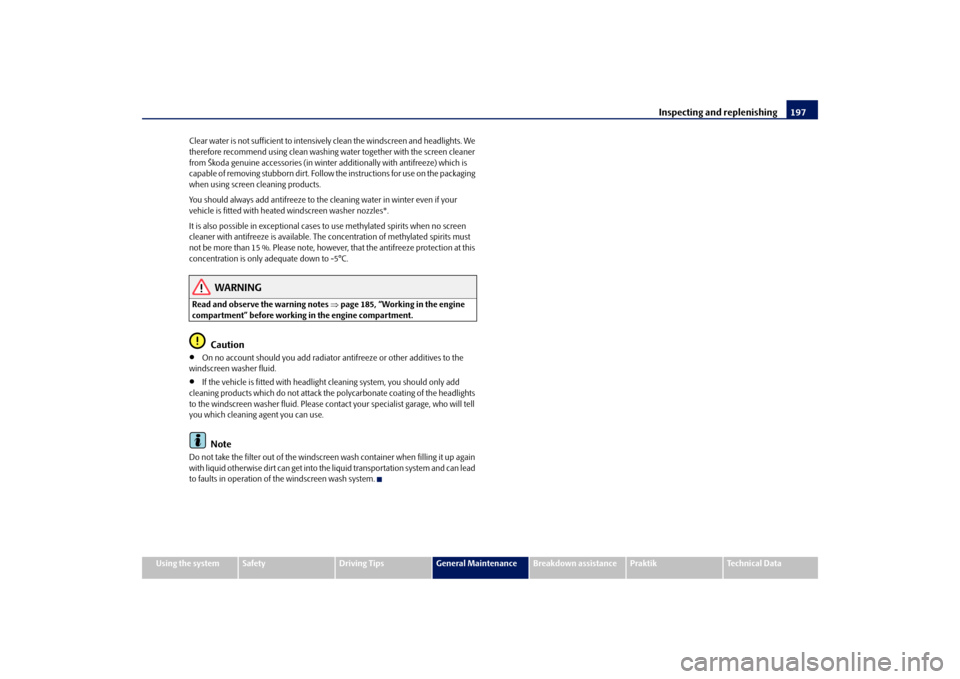
Inspecting and replenishing197
Using the system
Safety
Driving Tips
General Maintenance
Breakdown assistance
Praktik
Technical Data Clear water is not sufficient to intensively clean the windscreen and headlights. We
therefore recommend using clean washing water together with the screen cleaner
from Škoda genuine accessories (in winter additionally with antifreeze) which is
capable of removing stubborn dirt. Follow the instructions for use on the packaging
when using screen cleaning products.
You should always add antifreeze to the cleaning water in winter even if your
vehicle is fitted with heated windscreen washer nozzles*.
It is also possible in exceptional cases to use methylated spirits when no screen
cleaner with antifreeze is available. The concentration of methylated spirits must
not be more than 15 %. Please note, however, that the antifreeze protection at this
concentration is only adequate down to -5°C.
WARNING
Read and observe the warning notes ⇒page 185, “Working in the engine
compartment” before working in the engine compartment.
Caution
•
On no account should you add radiator antifreeze or other additives to the
windscreen washer fluid.
•
If the vehicle is fitted with headlight cleaning system, you should only add
cleaning products which do not attack the polycarbonate coating of the headlights
to the windscreen washer fluid. Please contact your specialist garage, who will tell
you which cleaning agent you can use.Note
Do not take the filter out of the windscreen wash container when filling it up again
with liquid otherwise dirt can get into the liquid transportation system and can lead
to faults in operation of the windscreen wash system.
s29g.4.book Page 197 Wednesday, June 17, 2009 9:54 AM
Page 200 of 263
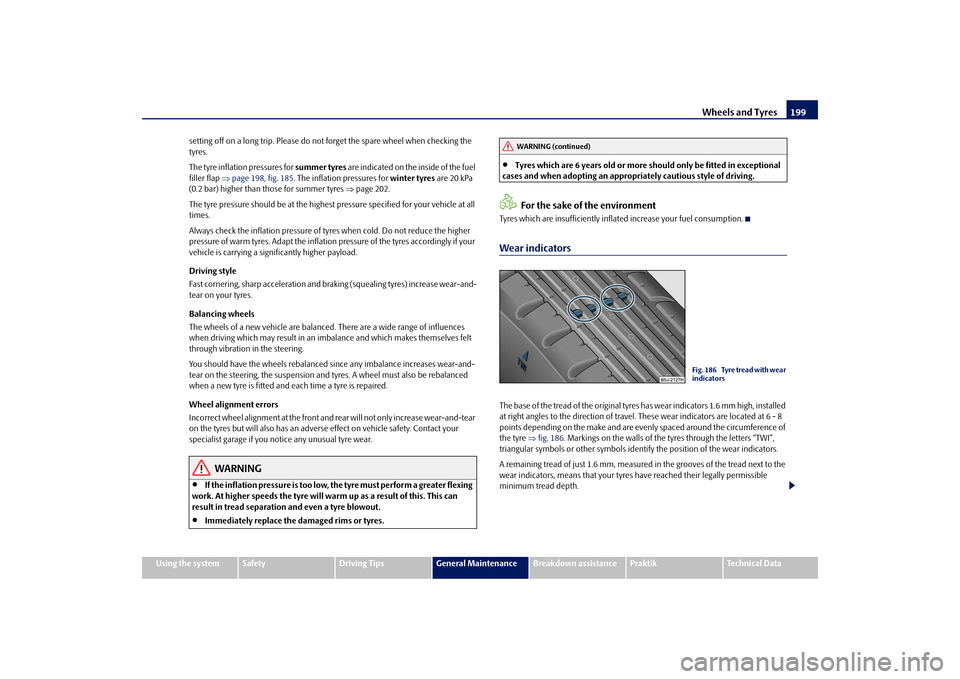
Wheels and Tyres199
Using the system
Safety
Driving Tips
General Maintenance
Breakdown assistance
Praktik
Technical Data setting off on a long trip. Please do not forget the spare wheel when checking the
tyres.
The tyre inflation pressures for summer tyres are indicated on the inside of the fuel
filler flap ⇒page 198, fig. 185. The inflation pressures for winter tyres are 20 kPa
(0.2 bar) higher than those for summer tyres ⇒page 202.
The tyre pressure should be at the highest pressure specified for your vehicle at all
times.
Always check the inflation pressure of tyres when cold. Do not reduce the higher
pressure of warm tyres. Adapt the inflation pressure of the tyres accordingly if your
vehicle is carrying a significantly higher payload.
Driving style
Fast cornering, sharp acceleration and braking (squealing tyres) increase wear-and-
tear on your tyres.
Balancing wheels
The wheels of a new vehicle are balanced. There are a wide range of influences
when driving which may result in an imbalance and which makes themselves felt
through vibration in the steering.
You should have the wheels rebalanced since any imbalance increases wear-and-
tear on the steering, the suspension and tyres. A wheel must also be rebalanced
when a new tyre is fitted and each time a tyre is repaired.
Wheel alignment errors
Incorrect wheel alignment at the front and rear will not only increase wear-and-tear
on the tyres but will also has an adverse effect on vehicle safety. Contact your
specialist garage if you notice any unusual tyre wear.
WARNING
•
If the inflation pressure is too low, the tyre must perform a greater flexing
work. At higher speeds the tyre will warm up as a result of this. This can
result in tread separation and even a tyre blowout.
•
Immediately replace the damaged rims or tyres.
•
Tyres which are 6 years old or more should only be fitted in exceptional
cases and when adopting an appropriately cautious style of driving.For the sake of the environment
Tyres which are insufficiently inflated increase your fuel consumption.Wear indicatorsThe base of the tread of the original tyres has wear indicators 1.6 mm high, installed
at right angles to the direction of travel. These wear indicators are located at 6 - 8
points depending on the make and are evenly spaced around the circumference of
the tyre ⇒fig. 186. Markings on the walls of the tyres through the letters “TWI”,
triangular symbols or other symbols identify the position of the wear indicators.
A remaining tread of just 1.6 mm, measured in the grooves of the tread next to the
wear indicators, means that your tyres have reached their legally permissible
minimum tread depth.
WARNING (continued)
Fig. 186 Tyre tread with wear
indicators
s29g.4.book Page 199 Wednesday, June 17, 2009 9:54 AM
Page 202 of 263
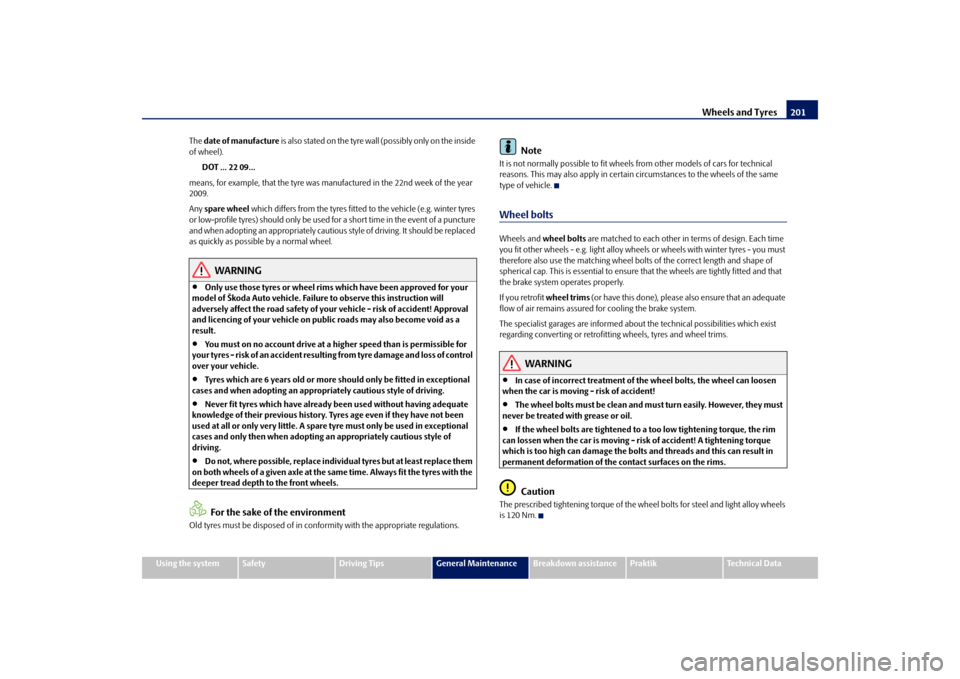
Wheels and Tyres201
Using the system
Safety
Driving Tips
General Maintenance
Breakdown assistance
Praktik
Technical Data The date of manufacture is also stated on the tyre wall (possibly only on the inside
of wheel).
DOT ... 22 09...
means, for example, that the tyre was manufactured in the 22nd week of the year
2009.
Any spare wheel which differs from the tyres fitted to the vehicle (e.g. winter tyres
or low-profile tyres) should only be used for a short time in the event of a puncture
and when adopting an appropriately cautious style of driving. It should be replaced
as quickly as possible by a normal wheel.
WARNING
•
Only use those tyres or wheel rims which have been approved for your
model of Škoda Auto vehicle. Failure to observe this instruction will
adversely affect the road safety of your vehicle - risk of accident! Approval
and licencing of your vehicle on public roads may also become void as a
result.
•
You must on no account drive at a higher speed than is permissible for
your tyres - risk of an accident resulting from tyre damage and loss of control
over your vehicle.
•
Tyres which are 6 years old or more should only be fitted in exceptional
cases and when adopting an appropriately cautious style of driving.
•
Never fit tyres which have already been used without having adequate
knowledge of their previous history. Tyres age even if they have not been
used at all or only very little. A spare tyre must only be used in exceptional
cases and only then when adopting an appropriately cautious style of
driving.
•
Do not, where possible, replace individual tyres but at least replace them
on both wheels of a given axle at the same time. Always fit the tyres with the
deeper tread depth to the front wheels.For the sake of the environment
Old tyres must be disposed of in conformity with the appropriate regulations.
Note
It is not normally possible to fit wheels from other models of cars for technical
reasons. This may also apply in certain circumstances to the wheels of the same
type of vehicle.Wheel boltsWheels and wheel bolts are matched to each other in terms of design. Each time
you fit other wheels - e.g. light alloy wheels or wheels with winter tyres - you must
therefore also use the matching wheel bolts of the correct length and shape of
spherical cap. This is essential to ensure that the wheels are tightly fitted and that
the brake system operates properly.
If you retrofit wheel trims (or have this done), please also ensure that an adequate
flow of air remains assured for cooling the brake system.
The specialist garages are informed about the technical possibilities which exist
regarding converting or retrofitting wheels, tyres and wheel trims.
WARNING
•
In case of incorrect treatment of the wheel bolts, the wheel can loosen
when the car is moving - risk of accident!
•
The wheel bolts must be clean and must turn easily. However, they must
never be treated with grease or oil.
•
If the wheel bolts are tightened to a too low tightening torque, the rim
can lossen when the car is moving - risk of accident! A tightening torque
which is too high can damage the bolts and threads and this can result in
permanent deformation of the contact surfaces on the rims.Caution
The prescribed tightening torque of the wheel bolts for steel and light alloy wheels
is 120 Nm.
s29g.4.book Page 201 Wednesday, June 17, 2009 9:54 AM
Page 204 of 263
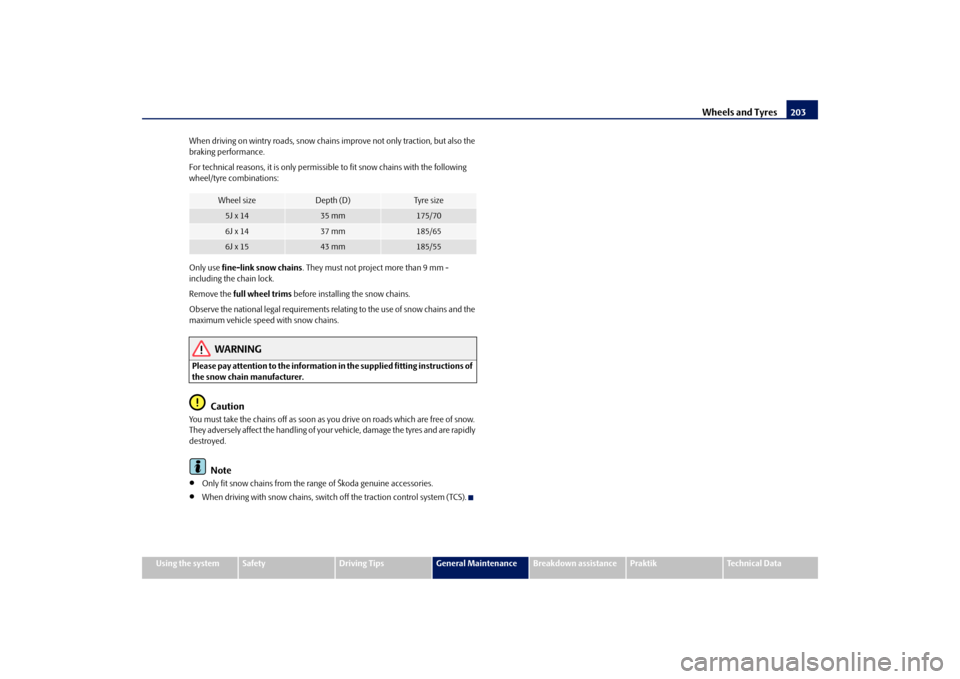
Wheels and Tyres203
Using the system
Safety
Driving Tips
General Maintenance
Breakdown assistance
Praktik
Technical Data When driving on wintry roads, snow chains improve not only traction, but also the
braking performance.
For technical reasons, it is only permissible to fit snow chains with the following
wheel/tyre combinations:
Only use fine-link snow chains. They must not project more than 9 mm -
including the chain lock.
Remove the full wheel trims before installing the snow chains.
Observe the national legal requirements relating to the use of snow chains and the
maximum vehicle speed with snow chains.
WARNING
Please pay attention to the information in the supplied fitting instructions of
the snow chain manufacturer.
Caution
You must take the chains off as soon as you drive on roads which are free of snow.
They adversely affect the handling of your vehicle, damage the tyres and are rapidly
destroyed.
Note
•
Only fit snow chains from the range of Škoda genuine accessories.
•
When driving with snow chains, switch off the traction control system (TCS).
Wheel size
Depth (D)
Tyre s iz e
5J x 14
35 mm
175/70
6J x 14
37 mm
185/65
6J x 15
43 mm
185/55
s29g.4.book Page 203 Wednesday, June 17, 2009 9:54 AM
Page 206 of 263
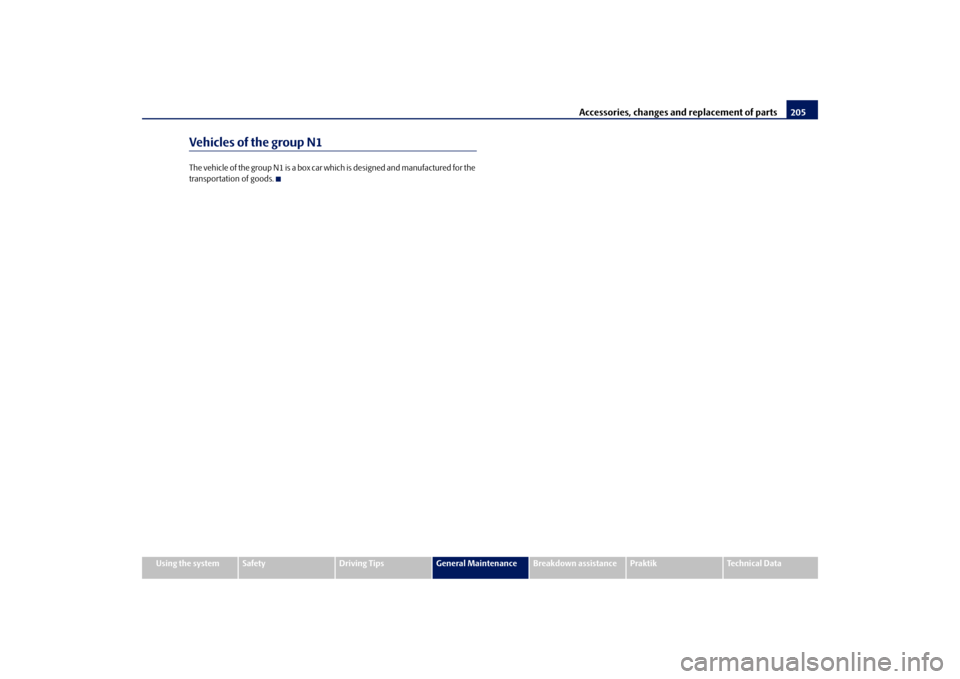
Accessories, changes and replacement of parts205
Using the system
Safety
Driving Tips
General Maintenance
Breakdown assistance
Praktik
Technical Data
Vehicles of the group N1The vehicle of the group N1 is a box car which is designed and manufactured for the
transportation of goods.
s29g.4.book Page 205 Wednesday, June 17, 2009 9:54 AM
Page 208 of 263
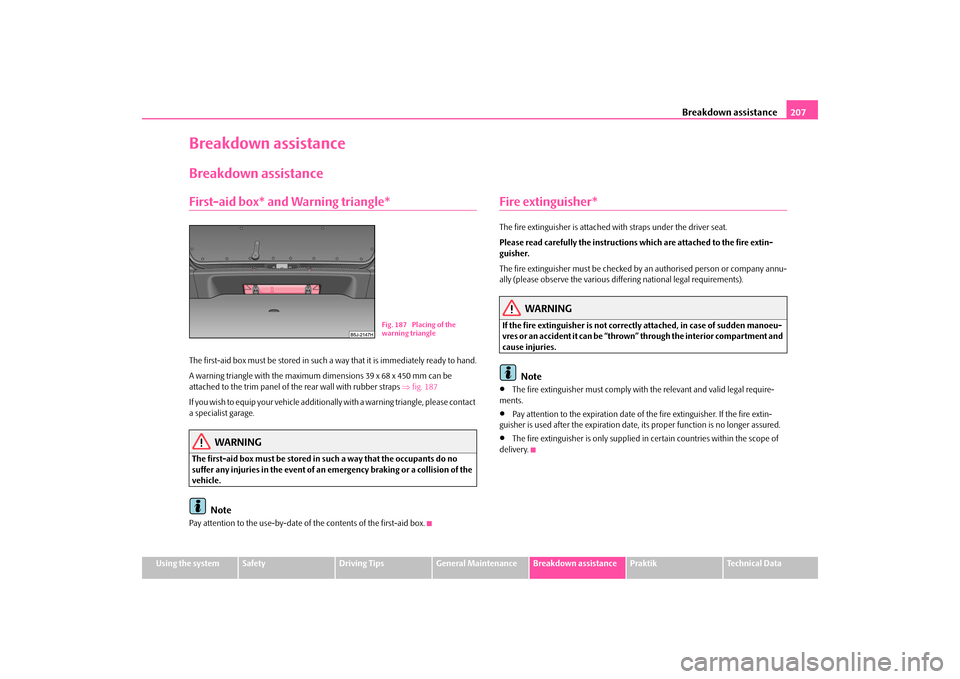
Breakdown assistance207
Using the system
Safety
Driving Tips
General Maintenance
Breakdown assistance
Praktik
Technical Data
Breakdown assistanceBreakdown assistanceFirst-aid box* and Warning triangle*The first-aid box must be stored in such a way that it is immediately ready to hand.
A warning triangle with the maximum dimensions 39 x 68 x 450 mm can be
attached to the trim panel of the rear wall with rubber straps ⇒fig. 187
If you wish to equip your vehicle additionally with a warning triangle, please contact
a specialist garage.
WARNING
The first-aid box must be stored in such a way that the occupants do no
suffer any injuries in the event of an emergency braking or a collision of the
vehicle.
Note
Pay attention to the use-by-date of the contents of the first-aid box.
Fire extinguisher*The fire extinguisher is attached with straps under the driver seat.
Please read carefully the instructions which are attached to the fire extin-
guisher.
The fire extinguisher must be checked by an authorised person or company annu-
ally (please observe the various differing national legal requirements).
WARNING
If the fire extinguisher is not correctly attached, in case of sudden manoeu-
vres or an accident it can be “thrown” through the interior compartment and
cause injuries.
Note
•
The fire extinguisher must comply with the relevant and valid legal require-
ments.
•
Pay attention to the expiration date of the fire extinguisher. If the fire extin-
guisher is used after the expiration date, its proper function is no longer assured.
•
The fire extinguisher is only supplied in certain countries within the scope of
delivery.
Fig. 187 Placing of the
warning triangle
s29g.4.book Page 207 Wednesday, June 17, 2009 9:54 AM
Page 210 of 263
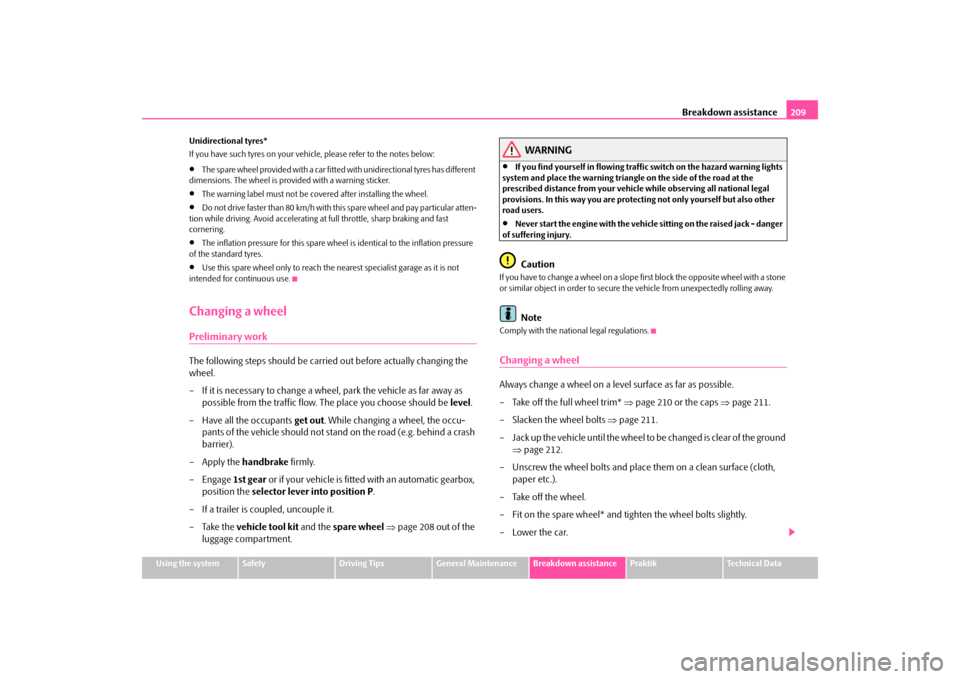
Breakdown assistance209
Using the system
Safety
Driving Tips
General Maintenance
Breakdown assistance
Praktik
Technical Data Unidirectional tyres*
If you have such tyres on your vehicle, please refer to the notes below:
•
The spare wheel provided with a car fitted with unidirectional tyres has different
dimensions. The wheel is provided with a warning sticker.
•
The warning label must not be covered after installing the wheel.
•
Do not drive faster than 80 km/h with this spare wheel and pay particular atten-
tion while driving. Avoid accelerating at full throttle, sharp braking and fast
cornering.
•
The inflation pressure for this spare wheel is identical to the inflation pressure
of the standard tyres.
•
Use this spare wheel only to reach the nearest specialist garage as it is not
intended for continuous use.
Changing a wheelPreliminary workThe following steps should be carried out before actually changing the
wheel.
– If it is necessary to change a wheel, park the vehicle as far away as
possible from the traffic flow. The place you choose should be level.
– Have all the occupants get out. While changing a wheel, the occu-
pants of the vehicle should not stand on the road (e.g. behind a crash
barrier).
– Apply the handbrake firmly.
–Engage 1st gear or if your vehicle is fitted with an automatic gearbox,
position the selector lever into position P.
– If a trailer is coupled, uncouple it.
– Take the vehicle tool kit and the spare wheel ⇒page 208 out of the
luggage compartment.
WARNING
•
If you find yourself in flowing traffic switch on the hazard warning lights
system and place the warning triangle on the side of the road at the
prescribed distance from your vehicle while observing all national legal
provisions. In this way you are protecting not only yourself but also other
road users.
•
Never start the engine with the vehicle sitting on the raised jack - danger
of suffering injury.Caution
If you have to change a wheel on a slope first block the opposite wheel with a stone
or similar object in order to secure the vehicle from unexpectedly rolling away.
Note
Comply with the national legal regulations.Changing a wheelAlways change a wheel on a level surface as far as possible.
– Take off the full wheel trim* ⇒page 210 or the caps ⇒page 211.
– Slacken the wheel bolts ⇒page 211.
– Jack up the vehicle until the wheel to be changed is clear of the ground
⇒page 212.
– Unscrew the wheel bolts and place them on a clean surface (cloth,
paper etc.).
– Take off the wheel.
– Fit on the spare wheel* and tighten the wheel bolts slightly.
– Lower the car.
s29g.4.book Page 209 Wednesday, June 17, 2009 9:54 AM
Page 212 of 263

Breakdown assistance211
Using the system
Safety
Driving Tips
General Maintenance
Breakdown assistance
Praktik
Technical Data
Caution
•
Use the pressure of your hand, do not knock on the full wheel trim! Heavy
knocks mainly on the points where the full wheel trim has not been inserted into
the wheel, can result in damage to the guide and centering elements of the full
wheel trim.
•
First check for yourself that the theft-deterrent wheel bolt is located
⇒page 212, “Securing wheels against being stolen*” in the hole in the area of the
valve before fitting the full wheel trim onto a steel wheel which is attached with a
theft-deterrent wheel bolt.
Wheel bolts with caps*
The caps are designed to protect the wheel bolts.Pulling off
– Insert the plastic clip (in the car tool kit) sufficiently far onto the cap
until the inner catches of the clip are positioned at the collar of the
cap.
– Pull the cap off with the plastic clip ⇒fig. 191.
Installing
– Insert the caps onto the bolts.
Slackening and tightening wheel bolts
Slacken the wheel bolts before jacking up the vehicle.Slackening wheel bolts
– Insert the wheel wrench fully onto the wheel bolt
9).
– Grasp the end of the wrench and turn the bolt about one turn to the
left ⇒fig. 192.
Tightening wheel bolts
– Insert the wheel wrench fully onto the wheel bolt 9).
– Grasp the end of the wrench and turn the bolt to the right until it is
tight.
WARNING
Slacken the wheel bolts only a little (about one turn) as long as the vehicle
has not yet been jacked up - risk of an accident!.
Fig. 191 Changing a wheel:
Pull off cap from the wheel
bolt
9)Use the appropriate adapter for slackening and tightening the safety wheel bolts
⇒page 212.
Fig. 192 Changing a wheel:
Slackening wheel bolts
s29g.4.book Page 211 Wednesday, June 17, 2009 9:54 AM
Page 214 of 263
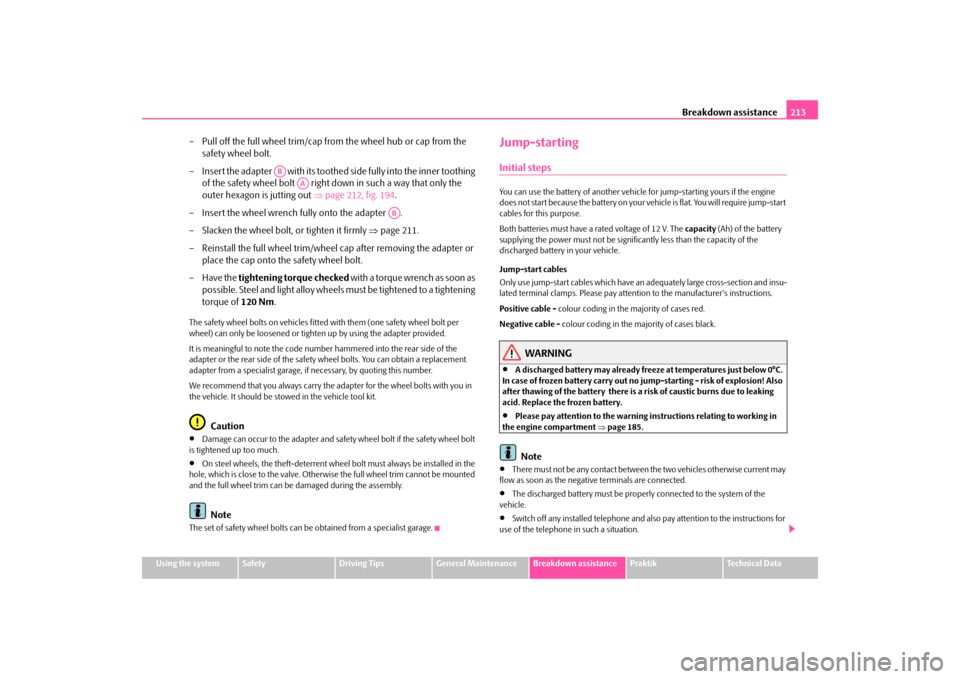
Breakdown assistance213
Using the system
Safety
Driving Tips
General Maintenance
Breakdown assistance
Praktik
Technical Data
– Pull off the full wheel trim/cap from the wheel hub or cap from the
safety wheel bolt.
– Insert the adapter with its toothed side fully into the inner toothing
of the safety wheel bolt right down in such a way that only the
outer hexagon is jutting out ⇒page 212, fig. 194.
– Insert the wheel wrench fully onto the adapter .
– Slacken the wheel bolt, or tighten it firmly ⇒page 211.
– Reinstall the full wheel trim/wheel cap after removing the adapter or
place the cap onto the safety wheel bolt.
–Have the tightening torque checked w i t h a t o rq u e w re n c h a s s o o n a s
possible. Steel and light alloy wheels must be tightened to a tightening
torque of 120 Nm.The safety wheel bolts on vehicles fitted with them (one safety wheel bolt per
wheel) can only be loosened or tighten up by using the adapter provided.
It is meaningful to note the code number hammered into the rear side of the
adapter or the rear side of the safety wheel bolts. You can obtain a replacement
adapter from a specialist garage, if necessary, by quoting this number.
We recommend that you always carry the adapter for the wheel bolts with you in
the vehicle. It should be stowed in the vehicle tool kit.
Caution
•
Damage can occur to the adapter and safety wheel bolt if the safety wheel bolt
is tightened up too much.
•
On steel wheels, the theft-deterrent wheel bolt must always be installed in the
hole, which is close to the valve. Otherwise the full wheel trim cannot be mounted
and the full wheel trim can be damaged during the assembly.Note
The set of safety wheel bolts can be obtained from a specialist garage.
Jump-startingInitial stepsYou can use the battery of another vehicle for jump-starting yours if the engine
does not start because the battery on your vehicle is flat. You will require jump-start
cables for this purpose.
Both batteries must have a rated voltage of 12 V. The capacity (Ah) of the battery
supplying the power must not be significantly less than the capacity of the
discharged battery in your vehicle.
Jump-start cables
Only use jump-start cables which have an adequately large cross-section and insu-
lated terminal clamps. Please pay attention to the manufacturer's instructions.
Positive cable - colour coding in the majority of cases red.
Negative cable - colour coding in the majority of cases black.
WARNING
•
A discharged battery may already freeze at temperatures just below 0°C.
In case of frozen battery carry out no jump-starting - risk of explosion! Also
after thawing of the battery there is a risk of caustic burns due to leaking
acid. Replace the frozen battery.
•
Please pay attention to the warning instructions relating to working in
the engine compartment ⇒page 185.Note
•
There must not be any contact between the two vehicles otherwise current may
flow as soon as the negative terminals are connected.
•
The discharged battery must be properly connected to the system of the
vehicle.
•
Switch off any installed telephone and also pay attention to the instructions for
use of the telephone in such a situation.
AB
AA
AB
s29g.4.book Page 213 Wednesday, June 17, 2009 9:54 AM
Page 216 of 263
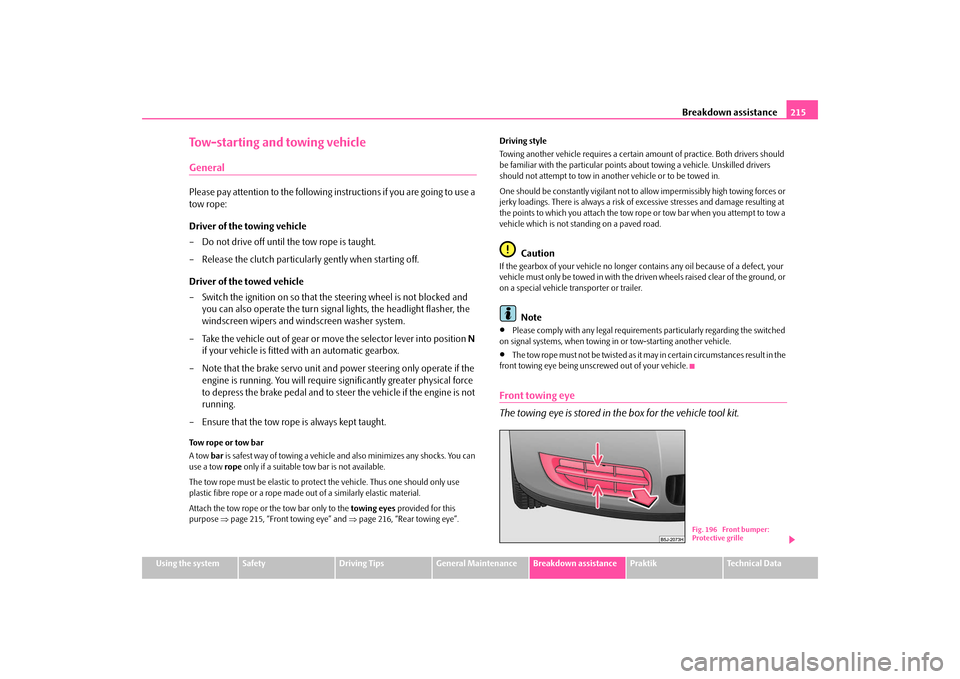
Breakdown assistance215
Using the system
Safety
Driving Tips
General Maintenance
Breakdown assistance
Praktik
Technical Data
Tow-starting and towing vehicleGeneralPlease pay attention to the following instructions if you are going to use a
tow rope:
Driver of the towing vehicle
– Do not drive off until the tow rope is taught.
– Release the clutch particularly gently when starting off.
Driver of the towed vehicle
– Switch the ignition on so that the steering wheel is not blocked and
you can also operate the turn signal lights, the headlight flasher, the
windscreen wipers and windscreen washer system.
– Take the vehicle out of gear or move the selector lever into position N
if your vehicle is fitted with an automatic gearbox.
– Note that the brake servo unit and power steering only operate if the
engine is running. You will require significantly greater physical force
to depress the brake pedal and to steer the vehicle if the engine is not
running.
– Ensure that the tow rope is always kept taught.Tow rope or tow bar
A tow bar is safest way of towing a vehicle and also minimizes any shocks. You can
use a tow rope only if a suitable tow bar is not available.
The tow rope must be elastic to protect the vehicle. Thus one should only use
plastic fibre rope or a rope made out of a similarly elastic material.
Attach the tow rope or the tow bar only to the towing eyes provided for this
purpose ⇒page 215, “Front towing eye” and ⇒page 216, “Rear towing eye”.Driving style
Towing another vehicle requires a certain amount of practice. Both drivers should
be familiar with the particular points about towing a vehicle. Unskilled drivers
should not attempt to tow in another vehicle or to be towed in.
One should be constantly vigilant not to allow impermissibly high towing forces or
jerky loadings. There is always a risk of excessive stresses and damage resulting at
the points to which you attach the tow rope or tow bar when you attempt to tow a
vehicle which is not standing on a paved road.
Caution
If the gearbox of your vehicle no longer contains any oil because of a defect, your
vehicle must only be towed in with the driven wheels raised clear of the ground, or
on a special vehicle transporter or trailer.
Note
•
Please comply with any legal requirements particularly regarding the switched
on signal systems, when towing in or tow-starting another vehicle.
•
The tow rope must not be twisted as it may in certain circumstances result in the
front towing eye being unscrewed out of your vehicle.
Front towing eye
The towing eye is stored in the box for the vehicle tool kit.
Fig. 196 Front bumper:
Protective grille
s29g.4.book Page 215 Wednesday, June 17, 2009 9:54 AM